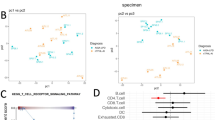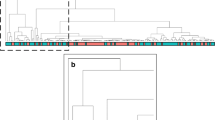Abstract
Histiocytic necrotizing lymphadenitis (HNL), also called Kikuchi-Fujimoto disease, is a benign, self-limiting inflammatory disease with fever and painful cervical lymphadenopathy of unknown etiology. A lymph node biopsy is required for the definitive diagnosis because of no specific symptoms or laboratory findings for HNL. To establish the rapid non-invasive diagnostic method for this disease, we investigated genes specifically expressed in the patients by analyzing whole transcriptome using microarray analysis of peripheral blood mononuclear cells (PBMC). The top five up-regulated genes (IFI44L, CXCL10, GBP1, EPSTI1 and IFI27) in HNL were interferon-induced genes (ISGs). The expression levels of the up-regulated genes by microarray were verified by quantitative PCR. High levels of serum CXCL10 concentration were confirmed at the symptomatic phase of HNL patients. The expression levels of these 5 genes positively correlated with each other (r2 = 0.28–0.60). The genes were also highly expressed in HNL lymph nodes. The discriminant analysis using the expression levels of these five genes distinguished HNL with 84 % accuracy. The combination of up-regulated ISGs in HNL seemed to be a specific response induced by viral infections or autoantigens. An analysis of the gene expression profile of PBMC may provide a rapid non-invasive diagnosis of HNL.





Similar content being viewed by others
Abbreviations
- ACTB:
-
Beta actin
- ADV:
-
Adenovirus
- AUC:
-
Area under the curve
- cDNA:
-
Complementary DNA
- CT :
-
Threshold cycle
- CXCL10:
-
Chemokine (C-X-C motif) ligand 10
- EPSTI1:
-
Epithelial stromal interaction 1 (breast)
- FluA:
-
Influenza type A virus
- GBP1:
-
Guanylate binding protein 1 interferon-inducible
- HNL:
-
Histiocytic necrotizing lymphadenitis
- IFN:
-
Interferon
- IFI27:
-
Interferon alpha-inducible protein 27
- IFI44L:
-
Interferon-induced protein 44-like
- IL:
-
Interleukin
- IM:
-
Infectious mononucleosis
- ISG:
-
Interferon-stimulated gene
- KD:
-
Kawasaki disease
- LNitis:
-
Purulent lymphadenitis
- PBMC:
-
Peripheral blood mononuclear cells
- PCR:
-
Polymerase chain reaction
- SLE:
-
Systemic lupus erythematosus
- SoJIA:
-
Systemic onset juvenile idiopathic arthritis
References
Bosch X, Guilabert A, Miquel R, Campo E. Enigmatic Kikuchi-Fujimoto disease: a comprehensive review. Am J Clin Pathol. 2004;122:141–52.
Hutchinson CB, Wang E. Kikuchi-Fujimoto disease. Arch Pathol Lab Med. 2010;134:289–93.
Yoshioka K, Miyashita T, Nakamura T, et al. Treatment of histiocytic necrotizing lymphadenitis (Kikuchi’s disease) with prolonged fever by a single course of methylprednisolone pulse therapy without maintenance therapy: experience with 13 cases. Intern Med. 2010;49:2267–70.
Pileri SA, Facchetti F, Ascani S, et al. Myeloperoxidase expression by histiocytes in Kikuchi’s and Kikuchi-like lymphadenopathy. Am J Pathol. 2001;159:915–24.
Pilichowska ME, Pinkus JL, Pinkus GS. Histiocytic necrotizing lymphadenitis (Kikuchi-Fujimoto disease): lesional cells exhibit an immature dendritic cell phenotype. Am J Clin Pathol. 2009;131:174–82.
Ohshima K, Shimazaki K, Kume T, et al. Perforin and Fas pathways of cytotoxic T-cells in histiocytic necrotizing lymphadenitis. Histopathology. 1998;33:471–8.
Ohshima K, Shimazaki K, Suzumiya J, et al. Apoptosis of cytotoxic T-cells in histiocytic necrotizing lymphadenitis. Virchows Arch. 1998;433:131–4.
Ohshima K, Karube K, Hamasaki M, et al. Apoptosis- and cell cycle-associated gene expression profiling of histiocytic necrotising lymphadenitis. Eur J Haematol. 2004;72:322–9.
Hu S, Kuo TT, Hong HS. Lupus lymphadenitis simulating Kikuchi’s lymphadenitis in patients with systemic lupus erythematosus: a clinicopathological analysis of six cases and review of the literature. Pathol Int. 2003;53:221–6.
Sumiyoshi Y, Kikuchi M, Takeshita M, et al. Alpha-interferon in Kikuchi’s disease. Virchows Arch B Cell Pathol Incl Mol Pathol. 1991;61:201–7.
Kubota M, Tsukamoto R, Kurokawa K, et al. Elevated serum interferon gamma and interleukin-6 in patients with necrotizing lymphadenitis (Kikuchi’s disease). Br J Haematol. 1996;95:613–5.
Ikeda K, Yamaguchi K, Tanaka T, et al. Unique activation status of peripheral blood mononuclear cells at acute phase of Kawasaki disease. Clin Exp Immunol. 2010;160:246–55.
Schmittgen TD, Livak KJ. Analyzing real-time PCR data by the comparative C(T) method. Nat Protoc. 2008;3:1101–8.
Schoggins JW, Wilson SJ, Panis M, et al. A diverse range of gene products are effectors of the type I interferon antiviral response. Nature. 2011;472:481–5.
Ohshima K, Haraoka S, Takahata Y, et al. Interferon-gamma, interleukin-18, monokine induced by interferon-gamma and interferon-gamma-inducible protein-10 in histiocytic necrotizing lymphadenitis. Leuk Lymphoma. 2002;43:1115–20.
Ishii T, Onda H, Tanigawa A, et al. Isolation and expression profiling of genes upregulated in the peripheral blood cells of systemic lupus erythematosus patients. DNA Res. 2005;12:429–39.
Ansell SM, Maurer MJ, Ziesmer SC, et al. Elevated pretreatment serum levels of interferon-inducible protein-10 (CXCL10) predict disease relapse and prognosis in diffuse large B-cell lymphoma patients. Am J Hematol. 2012;87:865–9.
Lee Y, Chittezhath M, Andre V, et al. Protumoral role of monocytes in human B-cell precursor acute lymphoblastic leukemia: involvement of the chemokine CXCL10. Blood. 2012;119:227–37.
Nzeusseu Toukap A, Galant C, Theate I, et al. Identification of distinct gene expression profiles in the synovium of patients with systemic lupus erythematosus. Arthritis Rheum. 2007;56:1579–88.
Naschberger E, Wenzel J, Kretz CC, et al. Increased expression of guanylate binding protein-1 in lesional skin of patients with cutaneous lupus erythematosus. Exp Dermatol. 2011;20:102–6.
Kimoto O, Sawada J, Shimoyama K, et al. Activation of the interferon pathway in peripheral blood of patients with Sjogren’s syndrome. J Rheumatol. 2011;38:310–6.
Szturz P, Adam Z, Chovancová J, et al. Cytokine analysis in a patient with relapsing Kikuchi-Fujimoto disease. Leuk Lymphoma. 2012;53:743–5.
Itsui Y, Sakamoto N, Kakinuma S, et al. Antiviral effects of the interferon-induced protein guanylate binding protein 1 and its interaction with the hepatitis C virus NS5B protein. Hepatology. 2009;50:1727–37.
Acknowledgments
We thank Department of Pathology, Faculty of Medicine, Fukuoka University, Japan, for the material support. The statistical analyses were advised by Junji Kishimoto at Kyushu University Hospital, Japan. This work was supported by a Grant-in-Aid for research on intractable diseases for Health and Labour Sciences Research Grants from the Ministry of Health, Labour and Welfare of Japan.
Author information
Authors and Affiliations
Corresponding author
Additional information
Masataka Ishimura and Hiroyuki Yamamoto contributed equally to this paper.
Rights and permissions
About this article
Cite this article
Ishimura, M., Yamamoto, H., Mizuno, Y. et al. A Non-invasive Diagnosis of Histiocytic Necrotizing Lymphadenitis by Means of Gene Expression Profile Analysis of Peripheral Blood Mononuclear Cells. J Clin Immunol 33, 1018–1026 (2013). https://doi.org/10.1007/s10875-013-9897-y
Received:
Accepted:
Published:
Issue Date:
DOI: https://doi.org/10.1007/s10875-013-9897-y




